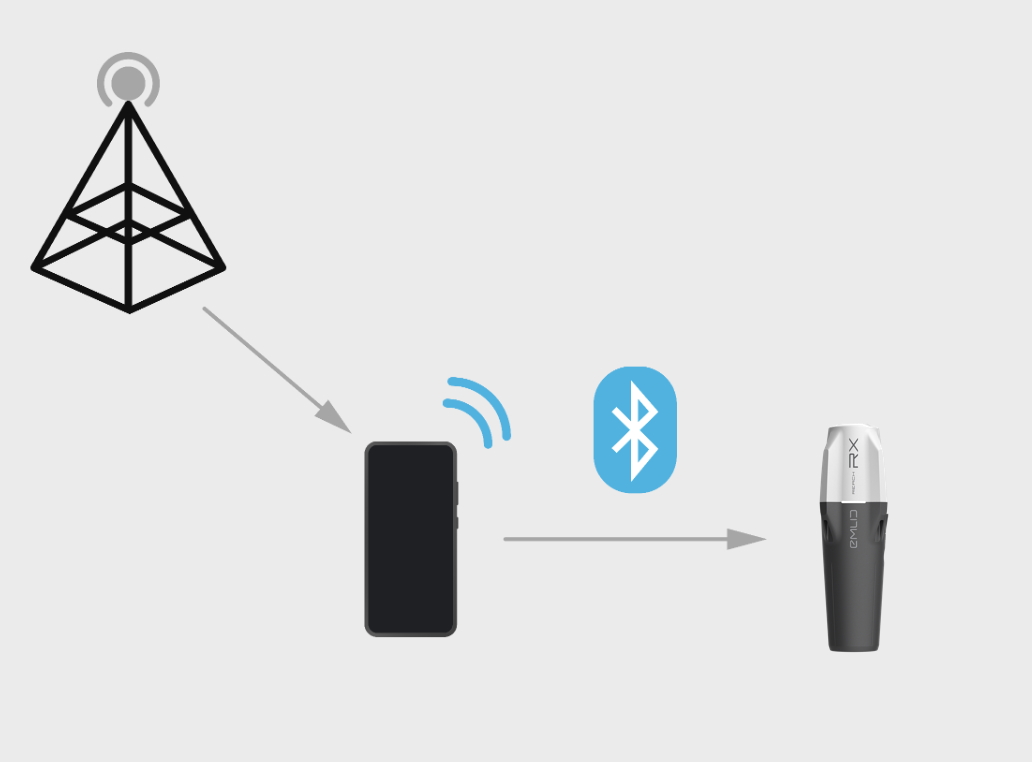RTK-Korrekturen und Ntrip-Caster
Echtzeitkinematik (RTK) ist eine Technik, die zur Verbesserung der Genauigkeit eines eigenständigen GNSS-Empfängers eingesetzt wird. Bei dieser Technik werden zwei Empfänger verwendet: ein stationärer und ein frei beweglicher. Sie werden als Basisstation und Rover bezeichnet. Die Basisstation liefert Korrekturdaten an den Rover, der anhand dieser Daten eine zentimetergenaue Position berechnet.
Sie brauchen nicht unbedingt immer ein zweites Gerät für RTK. In der Regel handelt es sich um lokale Dienste, die Basiskorrekturen über das Internet gemeinsam nutzen. Diese Technologie wird als Ntrip bezeichnet.
Reach RX ist ein Netzwerk-Rover, der Korrekturen über die Internetverbindung Ihres Telefons empfängt. Die Standardmethode hierfür ist das Ntrip-Protokoll.
Mehr über die RTK-Technologie erfahren Sie in dem Artikel So funktioniert RTK.
Ntrip-Protokoll-Übersicht
Ntrip (Networked Transport of RTCM via Internet Protocol) ist ein Kommunikationsprotokoll für die Übertragung von RTK-Korrekturdaten über das Internet. Das Protokoll basiert auf dem Client-Server-Modell, bei dem eine Referenzstation (der Server) Korrekturdaten an einen oder mehrere Rover (die Clients) über eine Internetverbindung sendet. Die Daten werden im RTCM-Format gesendet, einem Standardformat für GPS-Korrekturdaten.
Ntrip erfüllt 3 Hauptrollen: ein Server, ein Caster und ein Client.

Das Ntrip-Protokoll enthält auch einen Mechanismus namens „Einhängepunkte“, der es ermöglicht, mehrere Korrekturdatenströme von einem einzigen Server zu senden und den Rovern die Auswahl des zu empfangenden Stroms durch Angabe des Einhängepunkts in der Anfrage zu ermöglichen.
Eine vollständige Beschreibung des Ntrip-Protokolls finden Sie in der offiziellen Dokumentation.
Reach RX und Ntrip-Caster
Bei der Arbeit mit Reach RX fungieren mobile Apps und Datenerfasser als Ntrip-Clients und leiten die Korrekturdaten über Bluetooth an den Empfänger weiter. Die Apps fungieren als Brücke, die Korrekturen von einer Netzwerkverbindung zu einer Bluetooth-Verbindung weiterleitet.

NMEA-Rückmeldung
In vielen Fällen benötigen die Ntrip-Caster die ungefähre Position des Rover, um zu funktionieren. Sie benötigen die Position möglicherweise zur automatischen Bestimmung der geeigneten Basisstation oder für den VRS-Betrieb. Dies wird erreicht, indem Sie die ungefähre Position Ihres Rover (in der Regel die SINGLE-Lösung) als NMEA-GGA-String an den Caster senden, nachdem die Verbindung hergestellt wurde. Im Fall von Reach RX wird dies auch von der mobilen Anwendung übernommen.
NMEA-GGA-Nachrichten können unter Verwendung der Statusinformationen des Empfängers, die die Positionskoordinaten enthalten, gebildet werden.

In-App-Ntrip
Die Verwaltung der Ntrip-Caster in der Anwendung ist einfach. Um eine Verbindung zu einem Ntrip-Caster herzustellen, benötigen Sie in der Regel eine Adresse, einen Port, einen Einhängepunktnamen, einen Benutzernamen und ein Passwort.
Weitere Informationen zum Einrichten von RTK über Ntrip in Emlid Flow finden Sie in der Anleitung Arbeiten mit dem Ntrip-Dienst.
Es gibt auch einen optionalen Schritt, um die verfügbaren Einhängepunkte für diesen speziellen Caster zu bestimmen. Es ist möglich, eine Quelltabelle, die Informationen über aktive Einhängepunkte enthält, herunterzuladen und zu analysieren. Das vereinfacht den Prozess für den Endnutzer und ermöglicht smarte Tricks, wie die Empfehlung der nächstgelegenen Basisstation.
Ein Beispiel für die Quelltabelle finden Sie auf dieser Seite.
Ausweichlösung mit Emlid Flow
Emlid Flow für iOS unterstützt das Senden von Korrekturen im Hintergrund. Der Benutzer kann Korrekturen in Emlid Flow konfigurieren und mit der Arbeit in Ihrer App fortfahren. Die Verwendung von Emlid Flow für Korrekturen ist kostenlos und für alle Integratoren verfügbar.
Ntrip-Client innerhalb Ihrer App
Alternativ können Sie die Ntrip-Client-Funktionalität innerhalb Ihrer Anwendung implementieren.